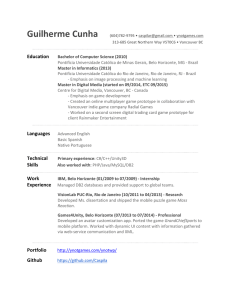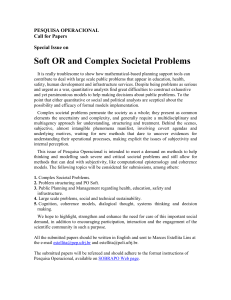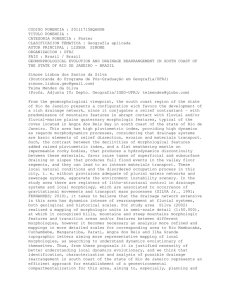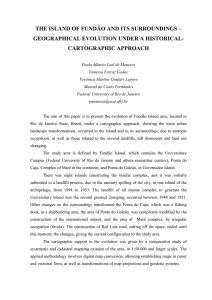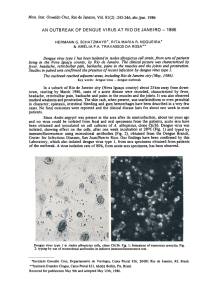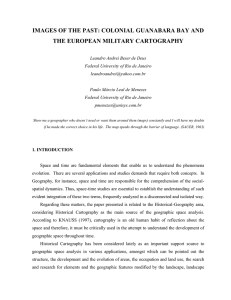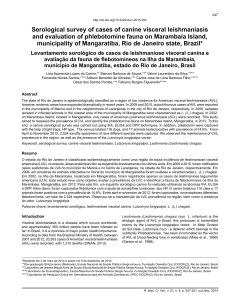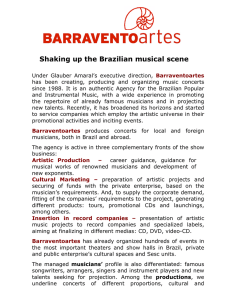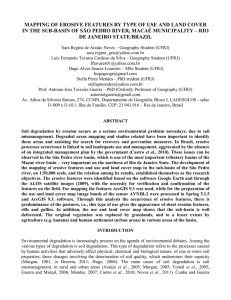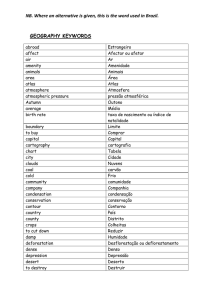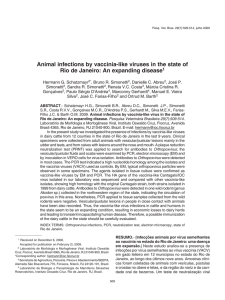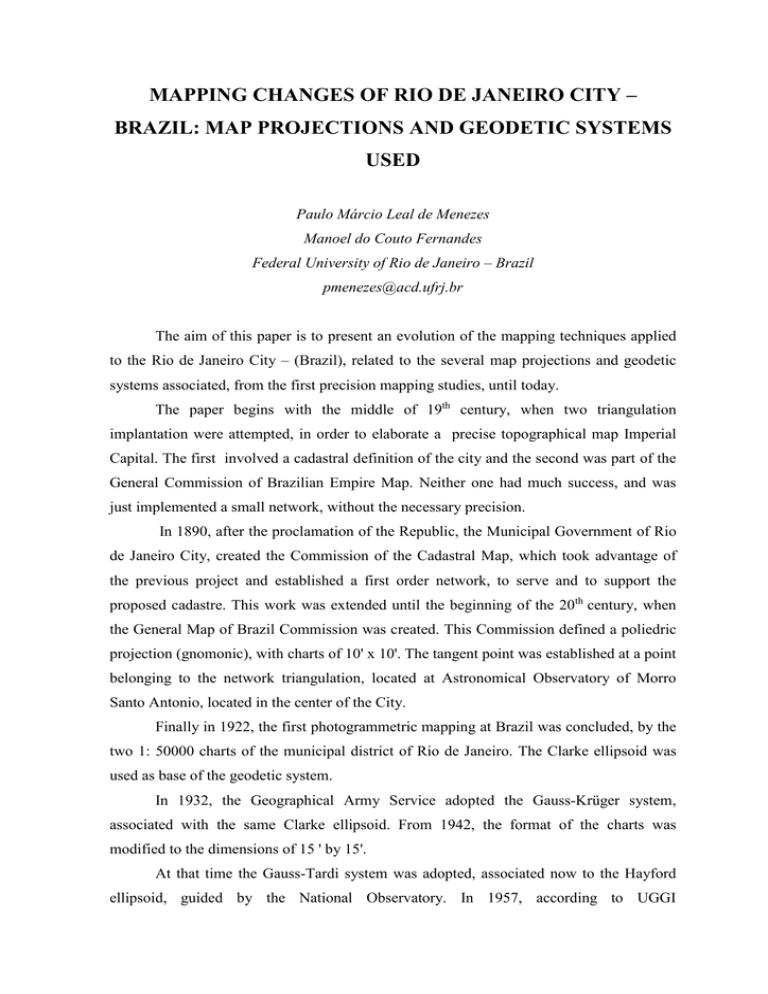
MAPPING CHANGES OF RIO DE JANEIRO CITY –
BRAZIL: MAP PROJECTIONS AND GEODETIC SYSTEMS
USED
Paulo Márcio Leal de Menezes
Manoel do Couto Fernandes
Federal University of Rio de Janeiro – Brazil
[email protected]
The aim of this paper is to present an evolution of the mapping techniques applied
to the Rio de Janeiro City – (Brazil), related to the several map projections and geodetic
systems associated, from the first precision mapping studies, until today.
The paper begins with the middle of 19th century, when two triangulation
implantation were attempted, in order to elaborate a precise topographical map Imperial
Capital. The first involved a cadastral definition of the city and the second was part of the
General Commission of Brazilian Empire Map. Neither one had much success, and was
just implemented a small network, without the necessary precision.
In 1890, after the proclamation of the Republic, the Municipal Government of Rio
de Janeiro City, created the Commission of the Cadastral Map, which took advantage of
the previous project and established a first order network, to serve and to support the
proposed cadastre. This work was extended until the beginning of the 20th century, when
the General Map of Brazil Commission was created. This Commission defined a poliedric
projection (gnomonic), with charts of 10' x 10'. The tangent point was established at a point
belonging to the network triangulation, located at Astronomical Observatory of Morro
Santo Antonio, located in the center of the City.
Finally in 1922, the first photogrammetric mapping at Brazil was concluded, by the
two 1: 50000 charts of the municipal district of Rio de Janeiro. The Clarke ellipsoid was
used as base of the geodetic system.
In 1932, the Geographical Army Service adopted the Gauss-Krüger system,
associated with the same Clarke ellipsoid. From 1942, the format of the charts was
modified to the dimensions of 15 ' by 15'.
At that time the Gauss-Tardi system was adopted, associated now to the Hayford
ellipsoid, guided by the National Observatory. In 1957, according to UGGI
recommendations, the UTM map projection system was adopted, which is still in use until
today.
From that time just on some minor changes have been made, related to the used
geodetic systems, such as: Córrego Alegre, SAD-69 and nowadays SIRGAS 2000.
The paper will present all of the compatible structuring undertaken to conciliate the
different projective and geodetic systems and their transformations, shown by way of the
transformation models proposed and applied to the maps of Rio de Janeiro City.
1 – INTRODUCTION
The Brazilian first mapping attempts on medium scale, were accomplished in the
middle of the 19th century, more precisely in 1862, when was created the Empire General
Chart Commission. It was needed a precise triangulation net, definition of an ellipsoid and
projection system for mapping purposes. The works, at Empire level were not productive,
due to economical factors, however the mapping support were established, through the
implantation of the triangulation of Rio Grande do Sul and the beginning of the Neutral
Municipal district triangulation, in Rio de Janeiro, where was measured two bases.
Only in 1922, when the Chart of Federal District, in 1:50 000 was built, beginning
the photogrammetric mapping an effective map projection and geodetic systems (vertical
and horizontal datum) was adopted.
Several were the adopted map projections, as well as vertical and horizontal data,
adopted, until to the used in current days.
One of biggest problems, to allow the several transformations among map
projections and
datum system, was the correct definition of each one, with correct
parameters.
3 – RIO DE JANEIRO TRIANGULATIONS
The Works in Rio de Janeiro, began em 1866, supporting to organize the city
cadaster. Figure 1 shows the network schema.
The network was developed between two main bases. One was situated in Santa
Cruz and the other one in Magé. The first base was 2509,82 m large.
In the original project would be built as Astronomical Observatory in Santa Cruz, to
support coordinates and fundamental azimuth, as well as a tide control point in Sepetiba
Bay.
Figure 1 – Triangulation of Neutral Municipy
During the republican government, in 1890, it was created the Cadastral Chart
Commission, to organize the territorial map of the Federal District. The advisor and head
of this commission was Dr Manoel Pereira Reis.
4 – GENERAL CHART OF BRAZIL
In 1901 Brazilian Army Headquarter developed the project of General Chart of
Brazil, publishing a report where was all specifications to build the Chart.
The defined scale was 1: 100 000, with a amount of 3000 charts to be built each one
with 30’ x 30’ or circa 0,65 m x 0,60 m. The amount of 3000 maps shows how difficult
would be the project execution.
The map projection was a poliedric projection still used by others countries such
Germany, USA, Austria and Japan. This projection is a gnomonic one, adapted to each
map quadrangle. The projection center was the center of each map, tangent to Earth
surface.
Some worldwide and national facts affected the work development, 1914 world war
and some revolutionary movements. In 1917 was created the Geographical Army Service
and it was initiated the photogrammetric operations, when came to Brazil a Austrian
Cartographic Mission, with 22 officer from the Austrian Army, all of them specialized in
geodetic and cartographic operations.
5 – RIO DE JANEIRO MAPPING
5.1 – Photogrammetric Chart of 1922
From 1919 Geographical Army Service worked to finished the triangulation of Rio
de Janeiro, from the old one did in 1890, defining points of first, second and third orders.
Figure 2 shows the representation of this network.
TRIÂNGULAÇÃO DO DISTRICTO FEDERAL
Cidade do Rio de Janeiro -1919
1a Ordem
2a Ordem
Escala Gráfica
3a Ordem
0
5000
10000
15000
20000 m
Fonte: Serviço Geográfico do Exército, 1937
Figure 2 –1st , 2nd e 3rd orders Triangulation
It had 21 1st order points, 37 of second and 58 of third, supporting the first
photogrammetric mapping done in Brazil. The aim of was to do the mapping of Federal
District, defined by Rio de Janeiro City, in a 1: 50 000 scale. The principal characteristic of
that mapping was:
- Gnomonic Projection, tangent to Observatory of Morro de Santo Antonio;
0 = -22 54’ 30,55”; 0 = - 43 10’ 47,03”, Elipsoid: Clarke
- Two sheets of 34,5 km x 38 km e 35,5 x 38 km, 0.65 x 0.70 cm;
- Coordinates in kilometers referenced to the tangent point as (0,0).
Figure 3 shows the mapping.
Figura 3 – Chart of Rio de Janeiro - 1922
This map supported all mappings from Federal District from this date to 1957.
Some updates were made only by transformations of coordinates systems.
5.2 – 1932/ 37 Chart –Gauss-Krüger Projection or Gauss Conformal
In 1932 after a reorganize of Geographical Army Service, the systematic mapping
of Brazil was adopted to scales 1: 25 000 to 1: 1 000 000. Between 1: 25 000 and 1:
250000, was chose Gauss Conformal according Krüger studies. All mapping was
transformed to new specification. S The characteristics of that mapping were the
following ones:
- Sheets with 10’ x 10’, to 1:50 000 scale;
-Gauss Conformal Projection or Gauss-Krüger;
- Grid with 3 of amplitud;
- Tangent Cylinder at central meridian;
- Equator Constant = 0;
- Central meridian Constant = 0;
Figure 3 shows Rio de Janeiro sheets
Figura 3 –Gauss-Küger Projection sheets to Rio de Janeiro
Figure 4 shows one sheet. In this system.
Figure 4 –Rio de Janeiro sheet –Gauss-Krüger Projection
The horizontal datum was changed to National Observatory at Valongo,
substituting the other one on Morro de Santo Antonio.
5.3 – Gauss-Tardi Projection – 1943
A new projection was adopted in 1943. The projection was the same Tranverse
Gauss Conformal, with a secant cylinder instead a tangent one, under Pierre Tardi
conception. Others changes was a UTM grid with 6 degrees amplitude zones, with central
meridians multiple of 6. Others characterize:
- Scale factor ho = 0,999333...;
- Sheet dimensions 1:50 000, 15’ x 15’
- Origin of partial coordinate systems adding the values
5.000 km to Equator,
500 km to central meridian;
Figure 5 shows the sheets in study area.
Figura 5 –Gauss-Tardi Projection applied to Rio de Janeiro
The horizontal datum was situated at National Observatory and it was used Hayford
ellipsoid
5.4 – UTM Projection – 1955
According 1955 General Assembly from Brussels, Brazil adopted UTM projection.
Two major changes was fitting with World International Chart, where the UTM zones are
defined multiple of 6 meridians. The additives constants are 500 000 m to central meridian
and 10 000 000 to Equator. The scale factor at central meridian was defined to 0.9996.
From 1957, all sheets of systematical and cadastral mapping are this projection,
changing only geodetic systems applied.
Table 1 shows the several geodetic systems used:
Date
Ellipsoid
Horizontal datum
Geodetic system
1955
Hayford
National Observatory
1964
Hayford
Córrego Alegre
Córrego alegre
1987
Ref 67
Chuá
SAD 69
2006
WGS84
Geocentric
SIRGAS 2000
6 –TRANSFORMING GEODETIC AND PROJECTION SYSTEMS
As defined, the several used geodetic and projection systems do not allows to
associate the same coordinate system. Once each one is vectorized its coordinate system
may be converted to one defined system. Once all of them are in a unique system,
(coordinate, datum and projection), they may be put as in temporal layers. In this way it is
needed to transform each one to the same system. The models and systems defined in
some coordinates transformation software didn’t present good results, and this problem is
being verified.
Affine transformation model needs an elevated number of control points, but
without control in areas with no control points. Sometimes control point acquisition is
defined over maps, and this is also a serious problem. In other hand there is few points
identified in all systems.
The coordinate transformation process adopted involved transformations to Earth
coordinates system at each ellipsoid, before the transformation to one of the projections
systems. This process may be viewed in figure 6.
PROJECTION AND GEODETIC SYSTEM TRANSFORMATION FLOWCHART
Rio de Janeiro - Brazil
Gnomonic
Clarke - 1880
LL
Clarke - 1880
Gauss-Krüger
Clarke
LL
SAD 69
Gauss-Tardi
Hayford
LL
Hayford
UTM
SAD 69
LL
SIRGAS
UTM
SIRGAS
Figure 6 – Projection transformation process
7 - CONCLUSIONS
The several projections and geodetic systems used in Rio de Janeiro, not allow the
simple transformations among each one. Problems about datum definitions are still studied,
because some transformations are not precise.
Some geodetic systems do not have transformation parameters to WGS 84, how
some software needs to do it. Some of them didn’t have defined which ellipsoid of one
family was used. By some attempts it was possible to define Clarke 1880 ellipsoid as one
of them.
The whole process is in programming and it’s added to some software to test it.
8 – BIBLIOGRAPHY
ARLINGHAUS, S. L., Practical Handbook of Digital Terms and Concepts, CRC Press,
Boca Ratton. 1994.
BERTIN, J., Semiology of Graphics: Diagrams, Networks, Maps.. Madison, WI:
University of Wisconsin. 1983.
BOARD, C., Report of the Working Group on Cartographic Definitions, Cartographic
Journal, 29, pp 65-69. 1990.
BOYLE, A. R., Automated Cartography, World Cartography, 15, 63-70. 1979.
CENTRO DE ARQUITETURA E URBANISMO DO RIO DE JANEIRO, Do
Cosmógrafo ao Satélite: Mapas da Cidade do Rio de Janeiro, UFRJ, FUJB, 2000
CLARKE, K., Analytical and Computer Cartography, 2nd Ed, Prentice Hall, NJ, USA,
1995
CROMLEY, R. G., Digital Cartography. Englewood Cliffs, NJ, Prentice Hall, 1992, 317
pp.
FUNDREM, Fundação do Desenvolvimento da Região Metropolitana, Mapeamento 1: 10
000, 1975
IPP, Instituto Pereira Passos, Mapeamento Cadastral do Rio de Janeiro, 1998
KRAAK M. J. & ORMELING F. J., Cartography-Visualization of Spatial Data, Addison
Wesley Longman Limited, Essex, England, 222 pp. 1996.
LAMEGO, A. R., O Homem e a Guanabara, IBGE – Conselho Nacional de Geografia,
1964
LAURINI, R. & THOMPSON, D., Fundamental of Spatial Information Systems,
Academic Press, San Diego, 680 pp. 1994.
MARBLE, D. F., The Computer and Cartography, The American Cartographer, 14, 101103. 1987.
MENEZES, P. M. L., Notas de Aula de Cartografia e Cartografia Temática, Não
publicadas, Curso de Graduação em Geografia, Dep de Geografia, UFRJ, Rio de
Janeiro, RJ. 1996.
MENEZES, P. M. L., Notas de Aula de Cartografia Temática, Não publicadas, Curso de
Graduação em Geografia, Dep de Geografia, UFRJ, Rio de Janeiro, RJ. 1996.
MENEZES,P. M. L. Aquisição, Tratamento e Armazenamento de Cartas Topográficas
Digitalizadas, Tese de Mestrado, IME, RJ. 155 pp. 1987.
MENEZES, P. M. L., A Interface Cartografia-Geoecologia nos Estudos Diagnósticos e
Prognósticos da Paisagem: Um Modelo de Avaliação de Procedimentos AnalíticoIntegrativos. Orientadora: Ana Luiza Coelho Neto. Rio de Janeiro: UFRJ/ PósGraduação em Geografia, 2000. 271p. Tese de Doutorado
OLIVEIRA, C., Dicionário Cartográfico, IBGE, Rio de Janeiro, RJ. 1980.
PETERSON, M. P. Interactive and Animated Cartography, Prentice Hall, NY, 464 pp,
1995.
RHIND, D. H., Computer Assisted Cartography, Transactions, Institute of British
Geographers, 2, 71-97. 1977.
ROBINSON, A. H., MORRISON, J. L., MUEHRCKE, P. C., KIMERLING, A. J. and
GUPTILL, S. C., Elements of Cartography – 6th Ed, 544 pp, New York, John
Willey & Sons. 1995.
SARTHOU, C., Passado e Presente da Baía de Guanabara, Livraria Freitas Bastos S.ª, Rio
de Janeiro, 1964
SAUER, C. O., ed John Barger Leighly. Land and Life: A Selection from the Writings of
Carl Ortwin Sauer. Berkeley: University of California Press, 1963.
THROWER, J.W. N., Maps and civilization: cartography in culture and society, University
of Chicago Press, Chicago, p. 254. 1996.
TYNER, J., Introduction to Thematic Cartography, Englewood Cliffs, Prentice Hall, New
Jersey, 299 pp. 1992.
VIANNA, C. R., Generalização Cartográfica em Ambiente Digital Escala 1:250 000 a
Partir de Dados Cartográficos Digitais na Escala 1: 50 000, Tese de Mestrado, IME,
Rio de Janeiro. 1997.

